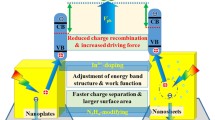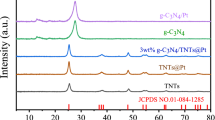Abstract
Solar-driven photoelectrochemical (PEC) water splitting is a promising technology for sustainable hydrogen production, which relies on the development of efficient and stable photoanodes for water oxidation reaction. The thickness and microstructure of semiconductor films are generally crucial to their PEC properties. Herein, three-dimensional (3D) interconnected nanoporous Ta3N5 film photoanodes with controlled thickness were successfully fabricated via galvanostatic anodization and NH3 nitridation. The porous Ta3N5 nanoarchitectures (NAs) of 900 nm in thickness showed the highest PEC performance due to the optimal light-harvesting and charge separation. Compared with the hole-induced photocorrosion, the electrochemical oxidation at high anodic potentials resulted in severer performance degradation of Ta3N5. Although the surface oxide layer on deteriorated Ta3N5 photoanodes could be removed by NH3 re-treatment, the PEC performance was only partially recovered. As an alternative, anchoring a dual-layer Co(OH)x/CoOOH co-catalyst shell on the porous Ta3N5 NAs demonstrated substantially enhanced PEC performance and stability. Overall, this work provides reference to controllably fabricate 3D nanoporous Ta3N5-based photoanodes for efficient and stable PEC water splitting via optimizing the light absorption, hole extraction, charge separation and utilization.

摘要
太阳能光电化学分解水是一种理想的绿色制氢技术, 而设计高效、 稳定的光阳极是目前面临的最大挑战. 考虑到薄膜厚度及其微观结构是影响光阳极性能的关键因素, 本文采用恒电流阳极氧化-NH3氮化法制备出厚度精准可控的三维贯通多孔纳米Ta3N5薄膜光阳极. 结果表明, Ta3N5厚度为900 nm时具有最高的光电解水性能, 这源于其最优的光吸收和电荷分离效率. 相比空穴自氧化, 高偏压下的电化学氧化会造成更严重的性能衰减. NH3氮化可去除Ta3N5表面氧化层, 但仅能部分恢复其性能, 而原位负载的Co(OH)x/CoOOH双层助催化剂则显著提高了Ta3N5的光电化学性能及稳定性. 本文提出通过厚度调控和表面修饰优化光吸收、 空穴转移和电荷分离, 为高效、 稳定的纳米多孔Ta3N5基光阳极的可控制备提供了新策略.
Similar content being viewed by others
References
Lewis NS. Research opportunities to advance solar energy utilization. Science, 2016, 351: aad1920
Chen Y, Feng X, Liu Y, et al. Metal oxide-based tandem cells for self-biased photoelectrochemical water splitting. ACS Energy Lett, 2020, 5: 844–866
Seo J, Nishiyama H, Yamada T, et al. Visible-light-responsive photoanodes for highly active, stable water oxidation. Angew Chem Int Ed, 2018, 57: 8396–8415
Pihosh Y, Minegishi T, Nandal V, et al. Ta3N5-nanorods enabling highly efficient water oxidation via advantageous light harvesting and charge collection. Energy Environ Sci, 2020, 13: 1519–1530
Li Y, Zhang L, Torres-Pardo A, et al. Cobalt phosphate-modified barium-doped tantalum nitride nanorod photoanode with 1.5% solar energy conversion efficiency. Nat Commun, 2013, 4: 2566
Chun WJ, Ishikawa A, Fujisawa H, et al. Conduction and valence band positions of Ta2O5, TaON, and Ta3N5 by UPS and electrochemical methods. J Phys Chem B, 2003, 107: 1798–1803
Ziani A, Nurlaela E, Dhawale DS, et al. Carrier dynamics of a visible-light-responsive Ta3N5 photoanode for water oxidation. Phys Chem Chem Phys, 2015, 17: 2670–2677
Chen S, Wang LW. Thermodynamic oxidation and reduction potentials of photocatalytic semiconductors in aqueous solution. Chem Mater, 2012, 24: 3659–3666
Hara M, Chiba E, Ishikawa A, et al. Ta3N5 and TaON thin films on Ta foil: Surface composition and stability. J Phys Chem B, 2003, 107: 13441–13445
He Y, Thorne JE, Wu CH, et al. What limits the performance of Ta3N5 for solar water splitting? Chem, 2016, 1: 640–655
Li Y, Takata T, Cha D, et al. Vertically aligned Ta3N5 nanorod arrays for solar-driven photoelectrochemical water splitting. Adv Mater, 2013, 25: 125–131
Liu G, Ye S, Yan P, et al. Enabling an integrated tantalum nitride photoanode to approach the theoretical photocurrent limit for solar water splitting. Energy Environ Sci, 2016, 9: 1327–1334
Wang L, Zhou X, Nguyen NT, et al. Strongly enhanced water splitting performance of Ta3N5 nanotube photoanodes with subnitrides. Adv Mater, 2016, 28: 2432–2438
Wang L, Nguyen NT, Zhou X, et al. Enhanced charge transport in tantalum nitride nanotube photoanodes for solar water splitting. ChemSusChem, 2015, 8: 2615–2620
Pei L, Wang H, Wang X, et al. Nanostructured TaON/Ta3N5 as a highly efficient type-II heterojunction photoanode for photoelectrochemical water splitting. Dalton Trans, 2018, 47: 8949–8955
Abel AJ, Garcia-Torregrosa I, Patel AM, et al. SILAR-deposited hematite films for photoelectrochemical water splitting: effects of Sn, Ti, thickness, and nanostructuring. J Phys Chem C, 2015, 119: 4454–4465
Feng X, Latempa TJ, Basham JI, et al. Ta3N5 nanotube arrays for visible light water photoelectrolysis. Nano Lett, 2010, 10: 948–952
Wang C, Hisatomi T, Minegishi T, et al. Thin film transfer for the fabrication of tantalum nitride photoelectrodes with controllable layered structures for water splitting. Chem Sci, 2016, 7: 5821–5826
Pinaud BA, Vesborg PCK, Jaramillo TF. Effect of film morphology and thickness on charge transport in Ta3N5/Ta photoanodes for solar water splitting. J Phys Chem C, 2012, 116: 15918–15924
Hajibabaei H, Little DJ, Pandey A, et al. Direct deposition of crystalline Ta3N5 thin films on FTO for PEC water splitting. ACS Appl Mater Interfaces, 2019, 11: 15457–15466
Li M, Luo W, Cao D, et al. A co-catalyst-loaded Ta3N5 photoanode with a high solar photocurrent for water splitting upon facile removal of the surface layer. Angew Chem Int Ed, 2013, 52: 11016–11020
Jin L, Cheng F, Li H, et al. Porous tantalum nitride single crystal at two-centimeter scale with enhanced photoelectrochemical performance. Angew Chem Int Ed, 2020, 59: 8891–8895
Wang Y, Zhu D, Xu X. Zr-doped mesoporous Ta3N5 microspheres for efficient photocatalytic water oxidation. ACS Appl Mater Interfaces, 2016, 8: 35407–35418
Khan S, Zapata MJM, Pereira MB, et al. Structural, optical and photoelectrochemical characterizations of monoclinic Ta3N5 thin films. Phys Chem Chem Phys, 2015, 17: 23952–23962
Khan S, Santos MJL, Malfatti CF, et al. Pristine Ta3N5 nanotubes: Trap-driven high external biasing perspective in semiconductor/electrolyte interfaces. Chem Eur J, 2016, 22: 18501–18511
Nguyen Van C, Thanh Hai N, Olejnicek J, et al. Preparation and photoelectrochemical performance of porous TiO2/graphene nanocomposite films. Mater Lett, 2018, 213: 109–113
Wang Q, Zhu H, Li B. Synergy of Ti-O-based heterojunction and hierarchical 1D nanobelt/3D microflower heteroarchitectures for enhanced photocatalytic tetracycline degradation and photoelectrochemical water splitting. Chem Eng J, 2019, 378: 122072
Wang L, Ji H, Wang S, et al. Preparation of Fe3O4 with high specific surface area and improved capacitance as a supercapacitor. Nanoscale, 2013, 5: 3793–3799
Khan S, Teixeira SR, Santos MJL. Controlled thermal nitridation resulting in improved structural and photoelectrochemical properties from Ta3N5 nanotubular photoanodes. RSC Adv, 2015, 5: 103284
Hou J, Cheng H, Takeda O, et al. Unique 3D heterojunction photoanode design to harness charge transfer for efficient and stable photoelectrochemical water splitting. Energy Environ Sci, 2015, 8: 1348–1357
Zhang P, Wang T, Zhang J, et al. Bridging the transport pathway of charge carriers in a Ta3N5 nanotube array photoanode for solar water splitting. Nanoscale, 2015, 7: 13153–13158
Wang Q, Zhang B, Lu X, et al. Multifunctional 3D K2Ti6O13 nanobelt-built architectures towards wastewater remediation: selective adsorption, photodegradation, mechanism insight and photoelectrochemical investigation. Catal Sci Technol, 2018, 8: 6180–6195
Grigorescu S, So S, Yoo JE, et al. Open top anodic Ta3N5 nanotubes for higher solar water splitting efficiency. Electrochim Acta, 2015, 182: 803–808
Allam NK, Feng XJ, Grimes CA. Self-assembled fabrication of vertically oriented Ta2O5 nanotube arrays, and membranes thereof, by one-step tantalum anodization. Chem Mater, 2008, 20: 6477–6481
El Ruby Mohamed A, Rohani S. Modified TiO2 nanotube arrays (TNTAs): progressive strategies towards visible light responsive photoanode, a review. Energy Environ Sci, 2011, 4: 1065–1086
Dang HX, Hahn NT, Park HS, et al. Nanostructured Ta3N5 films as visible-light active photoanodes for water oxidation. J Phys Chem C, 2012, 116: 19225–19232
Higashi M, Domen K, Abe R. Fabrication of efficient TaON and Ta3N5 photoanodes for water splitting under visible light irradiation. Energy Environ Sci, 2011, 4: 4138–4147
Xu K, Chatzitakis A, Jensen IJT, et al. Ta3N5/Co(OH)x composites as photocatalysts for photoelectrochemical water splitting. Photochem Photobiol Sci, 2019, 18: 837–844
Liao M, Feng J, Luo W, et al. Co3O4 nanoparticles as robust water oxidation catalysts towards remarkably enhanced photostability of a Ta3N5 photoanode. Adv Funct Mater, 2012, 22: 3066–3074
She H, Yue P, Ma X, et al. Fabrication of BiVO4 photoanode cocatalyzed with NiCo-layered double hydroxide for enhanced photoactivity of water oxidation. Appl Catal B-Environ, 2020, 263: 118280
Liu C, Xu Y, Luo H, et al. Synthesis and photoelectrochemical properties of CoOOH/phosphorus-doped hematite photoanodes for solar water oxidation. Chem Eng J, 2019, 363: 23–32
Ye KH, Wang Z, Li H, et al. A novel CoOOH/(Ti, C)-Fe2O3 nanorod photoanode for photoelectrochemical water splitting. Sci China Mater, 2018, 61: 887–894
Yaw CS, Tang J, Soh AK, et al. Synergistic effects of dual-electrocatalyst FeOOH/NiOOH thin films as effective surface photogenerated hole extractors on a novel hierarchical heterojunction photoanode structure for solar-driven photoelectrochemical water splitting. Chem Eng J, 2020, 380: 122501
Qiu Y, Liu W, Chen W, et al. Efficient solar-driven water splitting by nanocone BiVO4-perovskite tandem cells. Sci Adv, 2016, 2: e1501764
Xie X, Liu L, Chen R, et al. Long-term photoelectrochemical cathodic protection by Co(OH)2-modified TiO2 on 304 stainless steel in marine environment. J Electrochem Soc, 2018, 165: H3154–H3163
Xu D, Fu Z, Wang D, et al. A Ni(OH)2-modified Ti-doped α-Fe2O3 photoanode for improved photoelectrochemical oxidation of urea: the role of Ni(OH)2 as a cocatalyst. Phys Chem Chem Phys, 2015, 17: 23924–23930
Zhu K, Zhu G, Wang J, et al. Direct storage of holes in ultrathin Ni(OH)2 on Fe2O3 photoelectrodes for integrated solar charging battery-type supercapacitors. J Mater Chem A, 2018, 6: 21360–21367
Acknowledgements
This work was financially supported by the National Natural Science Foundation of China (51774145, 51872317 and 21835007), and China Postdoctoral Science Foundation (2019M661644). The first author also thanks the China Scholarship Council (CSC) for financial support.
Author information
Authors and Affiliations
Contributions
Author contributions Zhu H and Li B guided the project. Wang Q designed and performed the experiments; Zhang L and Shi J helped with the data analysis; Wang Q wrote the paper with support from Zhang L, Zhu H, Li B and Shi J. All authors contributed to the general discussion.
Corresponding authors
Ethics declarations
Conflict of interest The authors declare no competing financial interests.
Additional information
Qiang Wang received his PhD degree from East China University of Science and Technology (ECUST) in 2019. He is currently a postdoctoral fellow at Shanghai Institute of Ceramics, Chinese Academy of Sciences (SICCAS). His research focuses on photoelectrochemical solar fuel production and environmental remediation.
Lingxia Zhang received her PhD degree from SICCAS in 2003 and has been working at the institute since then. Currently her research interests include mesoporous and low-dimensional materials applied in artificial photosynthesis, CO2 conversion and environmental purification.
Bing Li received her PhD degree from Northeastern University in 2001. She joined the faculty of ECUST and was promoted to full professor in 2006. Her current research focuses on the design and fabrication of advanced energy storage and conversion materials.
Hongmin Zhu received his PhD degree from Tohoku University in 1989. He is now a professor in the Graduate School of Engineering, Tohoku University. His research interests include materials physical chemistry, metallurgical processing and synthesis of functional nanomaterials.
Supplementary Information
40843_2020_1584_MOESM1_ESM.doc
3D interconnected nanoporous Ta3N5 films for photoelectrochemical water splitting: thickness-controlled synthesis and insights into stability
Rights and permissions
About this article
Cite this article
Wang, Q., Zhang, L., Li, B. et al. 3D interconnected nanoporous Ta3N5 films for photoelectrochemical water splitting: thickness-controlled synthesis and insights into stability. Sci. China Mater. 64, 1876–1888 (2021). https://doi.org/10.1007/s40843-020-1584-6
Received:
Accepted:
Published:
Issue Date:
DOI: https://doi.org/10.1007/s40843-020-1584-6




